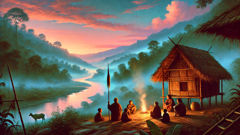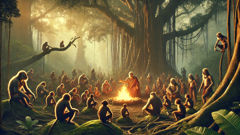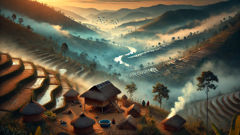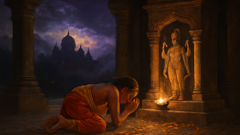Introduction
At daybreak the hills of what is now called Arunachal glow like a breath held and released. Mist lifts from the Siang and its tributaries, and the high ridges, dressed in pine and bamboo, exhale a scent of earth and old stories. In the oldest songs, the river remembers a single man who walked those valleys with a staff carved from the first wild cane, and with hands that learned the tilt of the plough and the knot of the net. They call him Abotani—the name changes by tongue and tribe, but his presence holds the same shape: the first man, the teacher, the one who listened to the voices of rivers, stones, and stars and returned to teach people how to live. This is neither a catalog of facts nor the tidy chronicle of a historian. It is a retelling, a careful weaving of versions gathered from fields and hearths, from festivals where drums beat and women in woven cloth step out in time, and from elders who trace patterns of lineage and land with their finger on the soil.
Across the highlands and river plains the Abotani story is told with variations as natural as the moss on the rocks. To the Adi people he is a progenitor, to the Apatani he is an ancestor who set the rules for cultivation, to other tribes he is the bringer of weaving patterns, the introducer of rites that keep the world in balance. This introduction sketches the terrain of the tale—the steep slopes, the sacred groves, the animal companions, and the intimate instructions Abotani left behind: how to sow seeds after the first rains, how to call the mithun and keep it gentle, how to set a hearth so that the smoke rises as a respectful messenger. Listen to the verses gathered here as if you stand at a village door on the edge of dusk, the last light varnishing the mountains, while stories and tea both steam between hands. Let the legend move like the river: sometimes slow and reflective, sometimes sudden, carving new paths where the land demands it.
Roots of the First Steps: Abotani’s Journey and the Birth of Ways
The earliest lines of the Abotani story are not written but planted in practice: terraces carved under his direction, seed varieties saved with prayers, the first trails trodden through reed and fern. In one widely shared telling, Abotani emerged from a cave of mist on a ridge where the sun can be seen as a coin of fire first lifting over the peaks. He was alone, and the land around him was raw and uninviting—steep slopes without paths, forests tangled, animals wary. Abotani took stock of what was given: stones too heavy to move alone, rivers that refused to be channeled, seeds that had no pattern of being planted. He listened, and the land answered. The wind brushed a slope in the shape of a terrace; the cry of a migrating bird taught him where a berry patch would thrive; the murmur of an underground spring taught him to dig where water would rise for crops.
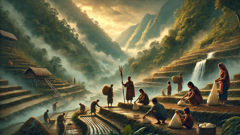
That listening was more than a metaphor in the telling. Abotani's hands learned to read small signs: a subtle dip that foretold a spring, the angle of a rock that sheltered soil from monsoon wash, which leaves kept insects at bay. He taught not by decree but by demonstration—showing his neighbors where to lay seeds in rows that caught both morning sun and evening rain, how to fashion a plough from a tree root without harming the heart of the tree so it would sprout again, how to braid reeds into traps that would not ruin the fish populations. The lesson embedded in these acts often surfaces in ritual: before planting, households call upon Abotani as they scatter the first seed, because to plant is to repeat his original listening.
Around such practical teachings, legend flourished. In one version Abotani wrestled with a wild tiger that had no place to hunt and a human that had no field; neither could live without the other. Finding a middle way, he drew a boundary line of millet and sugarcane, lines that the tiger recognized as non-hunting ground and that crowned the human fields with protection. In another, he coaxed the mighty mithun—part mythic beast, part living wealth—down from the high pastures with a whistle of reeds, teaching people to treat the animal as kin rather than as trophy. Many ritual songs that accompany the rearing of mithun today carry imprints of that account, lyric phrases about gentle guidance and shared pasture.
Abotani's relationships extended to the invisible too. He spoke to the spirits that the tribes now call Donyi (the Sun) and Polo (the Moon), and he negotiated a pact: if humans tended the land with care, respected the river-gods, and offered the first fruit, the celestial pair would keep rains and sun in balance. That compact frames how seasonal rites are performed. The Nyokum and other ceremonies that ask for fertility and harvest begin with invocations that echo lines reputed to be Abotani’s early words—simple petitions, woven with thanks. The rites double as a mnemonic; they are a way the community remembers what must not be forgotten: the costs of taking more than what the land will yield.
As the tale spreads along river and ridge, different tribes adapt its edges. For some Abotani's partner—sometimes called Abotani’s wife, other times represented as a female counterpart or many women—played a stronger role in teaching weaving and medicine, spinning the first cloth and naming the herbs. The Galo variant emphasizes the cunning of Abotani in tricking a mountain spirit into giving up a valley; the Apatani lean into his role as the founder of irrigation practices that make their terraced fields famous. Each version is shaped by the environmental knowledge of the people who tell it, and those differences are not contradictions but mirrors showing how a story can be both ancient and living.
The legend also records social rules. Abotani sets out prohibitions: never cut the grove that cleans the spring, never hunt during nesting, never bring back a hunted animal's entire family to the hearth—the old stories say these rules prevented the land from slipping out of balance. In practice, those maxims guide sustainable harvests and conservation-minded customs that endure. These customs are the story’s living roots: they testify that myth can be a form of ecological knowledge, passed through song and practice and the cadence of festivals. People repeating Abotani's prescriptions do more than honor an ancestor—they enact an ancestral contract, a compact with place.
Sometimes the legend takes darker turns. There are tales where Abotani misjudged a mountain spirit and paid a price, losing kin or fields, and sometimes he is tricked by a rival human who values immediate gain over communal balance. These episodes show the legend's moral flexibility: it cautions against hubris, greed, and impatience. Yet it also preserves a humane, forgiving core—Abotani, though a cultural hero, is fallible, and his stumbles become lessons. In villages now, elders sometimes intentionally perform a recounting of a mistake Abotani made when teaching the young; the retelling is not merely entertainment but an ethical rehearsal, a way to rehearse restraint and care.
Music and material culture carry the legend in their patterns. The first twined shawls, the introduction of the specific motif in apron weave, the cadence of the beating drum—each of these is narrated as a gift from Abotani. When a weaver draws a line of pattern that mimics a river's meander or a hunter sings a call shaped like an old whistle, they are renewing a conversation that began with one man and the listening land. In this way, Abotani lives in the ordinary, in the daily work of planting and mending, in the songs raised at dawn and in the small rituals before the door. He is a quiet tutor, and the people who say his name do so while attending to the practical arts that keep mountain life possible.
Those practicalities are wrapped in tenderness. The legend’s intimacy—its insistence that the first lessons were taught at hearthside rather than in a hall of decrees—shifts the focus from heroics to continuity. Abotani’s greatest legacy, many elders say, is not the plough or the net but the habit of passing things on: songs, tools, names of streams, and the patient measurements of where terraces should lie. Across the many tellings, the story insists that culture is an act of careful repetition, an anchor for memory that binds people to place and to each other.
The landscape of the highlands remembers this binding in topography named for him and in shrines where villagers leave betel, rice, or a thread from a newly woven cloth. These places are small, often a stone under a rhododendron or a clearing beside a bamboo copse, and each carries a story variant. Pilgrims do not come from afar as tourists, but neighbors do come from nearby hamlets to make offerings and to recite certain lines at planting and harvest. Those recitations are not uniform; they are personalized by families who trace different threads of descent to Abotani. The result is a mosaic of allegiance: the figure is the same, but the names of rivers and rites shift, giving the myth both unity and diversity, like a river braided into multiple channels as it reaches the plain.
Songs, Rites, and the Living Memory: How the Legend Breathes in Everyday Practice
If the first section explores Abotani's practical teachings and the ecological wisdom woven into them, this section follows the legend into the heart of custom: how songs, rituals, and domestic practices keep the figure alive and relevant. In the hill villages, the telling begins before harvest and ends long after the feast. During Nyokum and other seasonal ceremonies, when drums pulse and dancers move with bamboo poles and bells, Abotani's name is often invoked in the opening verses. The cadence of those verses is sewn into the ritual step, as steady and reliable as the planting line. Yet each ritual is improvisatory too—singers add local references, mention recent floods or a bountiful catch, or insert anecdotes about an elder whose cleverness solved a problem that would have undone a harvest. The legend thus functions as a living archive that both preserves and records.
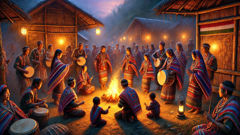
There are household practices that also tell the story. The kitchen fire is lit in a prescribed manner, with a small bowl of rice placed aside for unseen guests and an opening to the east kept free for the first light to enter. Elders say such acts are ways of honoring Abotani’s practice of leaving space for the good forces—those that the legend says once negotiated with the first man. Weaving patterns, often read as mere decoration by outsiders, are more like maps: a repeated zigzag might mark the path of a favored ancestral trail; a diamond could indicate where a spring once rose unexpectedly. In some lineages, a particular motif denotes that a family descends from the teller of a specific Abotani episode, and with that motif comes responsibility: to teach a certain song, to maintain a certain field, to hold the rope in a communal ritual. These duties are not burdensome; they are honors and a method of organizing memory.
Oral histories that recount Abotani's conversations with Donyi and Polo carry theological resonance. In these lines, Abotani is both a mediator and a translator: he translates heavenly order into human habit. The compact with Donyi-Polo often includes conditional blessings—when people honor the contract with careful rites and offerings, rains come in measured generosity; when they fail, the stories warn, the sky may be withheld. That conditionality gives ritual teeth: rites are not empty repetition but functional care. They encourage communities to monitor their relations with the environment—how many saplings are cut, whether fish traps are sized to allow juvenile fish to pass, whether animals are culled in fair proportion. In villages where modern pressures—logging, commercial hunting, and economy-driven land use—have strained tradition, elders often use the Abotani tale as a reasoned appeal rather than a mere superstition. They show how abiding by the old ways has kept soil and people healthy for generations.
The legend also structures social relationships. There are recitations performed when a young person becomes a head of household, when a marriage binds two families across a valley, when a new child is given a name that reflects a topographical sign or an event the family remembers. In many versions, Abotani is credited with naming the first few clans: he saw unique traits in people—the way one family sung, or another family tended reeds—and he gave them names connected to local features. Those clan names operate as anchors of identity, and through them the narrative of Abotani becomes a social charter: obligations to support kin, to share harvest in times of hardship, and to accept newcomers who abide by the covenant of care.
The multiplicity of versions is part of the point. Scholars and storytellers alike have noted that the Abotani legend acts as a communal mirror—it reflects collective anxieties, triumphs, and adaptive knowledge. In times of ecological stress, the telling leans into narratives of careful stewardship and the consequences of neglect. In seasons of plenty, the story accentuates the generosity of the first man and the importance of sharing. That elasticity is why the legend remains central across many tribes: it is a flexible primer for social life, with motifs that can be emphasized or softened depending on context.
There is also ceremonial humor embedded in many tellings. Abotani, despite his stature, is sometimes the butt of a playful anecdote: he mishears a bird call and follows it into a thicket, returning with a new kind of fruit that becomes a prized taste; or he is tricked by a mischievous neighbor who hides his cane, forcing Abotani to improvise a new tool. These humanizing touches make the hero accessible. They teach humility and creativity, and they encourage listeners, especially the young, to laugh at their mistakes. Elders use these parts of the legend to teach problem-solving—if Abotani could laugh and start anew, so can the next generation.
Material culture preserves the tale in objects: carved staffs, ritual masks, and weaving frames are sometimes designated as Abotani artifacts—not because they belonged to the original figure, but because their forms were described in a version of the story and then codified as sacred. A carved motif on a staff might be replicated across households because it was “taught by Abotani” in a story about guiding a wayward child back to the village. These objects become pedagogical tools; children learn by handling them, imitating the sequences of action that the tales recommend. This apprenticeship—learning by doing—bridges myth and craft.
When outsiders ask about the legend, villagers often answer with a mixture of pride and caution. Some fear the story will be flattened into tourist-friendly versions that strip its local nuance. Others welcome the wider attention because it brings recognition to practices that sustain fragile ecologies. Many communities now engage in a careful translation: they tell the story in ways that protect certain ritual particulars while sharing the broader moral and ecological themes. This selective sharing mirrors Abotani's own emphasis on measured disclosure—what must be kept private to maintain balance and what may be taught to ensure survival.
Finally, the living memory of Abotani shows how a myth can function as both anchor and compass. It anchors people to a past that is not static but practiced daily through songs, rites, and duties. It acts as a compass when decisions must be made about land use or social norms: the legend's lessons—listen to the land, make offerings, follow community rules—provide criteria for judgement. Abotani's presence in everyday life is less about veneration of a distant progenitor and more about an ongoing conversation. That conversation still happens beside hearths, on terraces, and along riverbanks, wherever people cultivate not only crops but also the common will to live within the limits and gifts of their place.
Conclusion
Legends survive because they are useful and beloved. The Abotani story does both: it gives a people their first steps and then offers them a language for remembering how those steps were taken. Across the ridges and valleys of Arunachal Pradesh, a thousand variations of the same essential tale continue to instruct and console. They teach how to read a spring, how to share the mithun, how to repair a net, and how to sing the land awake every season. They are living contracts that bind social life to ecological care, and they are expressive forms that allow communities to adapt without losing memory. When youth hear Abotani’s verses at dawn or when elders supervise the first furrow, they participate in an inheritance that is both practical and sacred. The legend endures because it is embedded in action, and action is how people make meaning. In honoring the memory of Abotani—whether by reciting a stanza, preserving a grove, or teaching a child to plait reeds—communities in Arunachal keep a steady promise: the past will guide the future, and the future will honor the past by listening.

